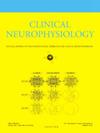更强的术前功能连接网络与颞叶癫痫手术效果的改善有关
IF 3.6
3区 医学
Q1 CLINICAL NEUROLOGY
引用次数: 0
摘要
目的探讨单侧颞叶癫痫患者手术后无癫痫发作与持续癫痫发作者术前静息状态脑电图的网络差异。方法回顾性分析15例单侧TLE患者,其中癫痫手术后无癫痫发作(SF)和13例术后持续癫痫发作(nSF)。在静息状态头皮脑电图片段上使用互相关技术测量功能连通性,这些片段没有任何视觉上明显的癫痫样异常。结果较强的术前功能连通性与良好的术后预后相关。SF组表现出明显更高的连通性强度,特别是在涉及右半球的跨半球和半球内网络(P = 0.02)。功能连接强度预测术后癫痫发作自由的准确率为75% (AUC = 0.77)。值得注意的是,尽管临床特征或影像学结果存在差异,但具有最强连通性的个体均无癫痫发作。连通性强度与年龄、病程、海马硬化或双侧癫痫样异常无关。结论视觉正常脑电图的功能连接网络可提供无创、无冗余的信息,可用于预测术后预后。意义:本研究进一步支持了癫痫是一种神经网络障碍的概念。本文章由计算机程序翻译,如有差异,请以英文原文为准。
Stronger pre-surgical functional connectivity networks are associated with improved surgical outcome in temporal lobe epilepsy
Objective
This study investigates the network differences in pre-surgical resting-state EEG between individuals with unilateral temporal lobe epilepsy who become seizure-free and those who continue to have seizures after epilepsy surgery.
Methods
We retrospectively identified 15 individuals with unilateral TLE who were seizure-free (SF) after epilepsy surgery and 13 who continued to have seizures post-surgery (nSF). Functional connectivity was measured using cross-correlation techniques on clips of resting-state scalp EEG that were free of any visually apparent epileptiform abnormalities.
Results
Stronger pre-surgical functional connectivity was associated with favorable post-surgical outcomes. The SF group demonstrated significantly higher connectivity strength, particularly in cross-hemispheric and intra-hemispheric networks involving the ictal hemisphere (P = 0.02). Functional connectivity strength predicted post-surgical seizure freedom with 75 % accuracy (AUC = 0.77). Notably, individuals with the strongest connectivity were all seizure-free, despite heterogeneity in clinical characteristics or imaging findings. Connectivity strength did not correlate with age, disease duration, hippocampal sclerosis, or bilateral epileptiform abnormalities.
Conclusion
Functional connectivity networks derived from visually normal EEG can provide non-invasive, non-redundant information beyond traditional assessments to predict post-surgical outcomes.
Significance
This study further supports the concept that epilepsy is a disorder of neural networks.
求助全文
通过发布文献求助,成功后即可免费获取论文全文。
去求助
来源期刊

Clinical Neurophysiology
医学-临床神经学
CiteScore
8.70
自引率
6.40%
发文量
932
审稿时长
59 days
期刊介绍:
As of January 1999, The journal Electroencephalography and Clinical Neurophysiology, and its two sections Electromyography and Motor Control and Evoked Potentials have amalgamated to become this journal - Clinical Neurophysiology.
Clinical Neurophysiology is the official journal of the International Federation of Clinical Neurophysiology, the Brazilian Society of Clinical Neurophysiology, the Czech Society of Clinical Neurophysiology, the Italian Clinical Neurophysiology Society and the International Society of Intraoperative Neurophysiology.The journal is dedicated to fostering research and disseminating information on all aspects of both normal and abnormal functioning of the nervous system. The key aim of the publication is to disseminate scholarly reports on the pathophysiology underlying diseases of the central and peripheral nervous system of human patients. Clinical trials that use neurophysiological measures to document change are encouraged, as are manuscripts reporting data on integrated neuroimaging of central nervous function including, but not limited to, functional MRI, MEG, EEG, PET and other neuroimaging modalities.
 求助内容:
求助内容: 应助结果提醒方式:
应助结果提醒方式:


